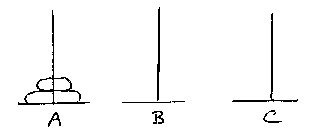-can only move one disk at a time
-can never put a larger disk on top of a smaller disk

-can calculate all the legal moves
see HANDOUT
consider the following problem: the TOWER OF HANOI problem
task: move disks such that the configuration on prong A is reproduced
on prong C
-can only move one disk at a time
-can never put a larger disk on top of a smaller
disk

-can calculate all the legal moves
see HANDOUT
-this universe of possible moves is the problem space in which the person
is working
-can study how people search through this problem space
an ANAGRAM: re-arrange the letters to create a real word
MEROPLB
How could one do this:
an Algorithmic approach: use a set of operations that is guaranteed to find an answer if an answer is available.. .example create every possible combination of the 7 letters, look up each one in a "dictionary"
an Heuristic approach: use a set of procedures that are "rules of thumb", these would have a high probability of success, but can fail to find an available answer;...example. put some letter combinations together but not others
in studying human problem solving: find people tend to use heuristics
1. generate-test
-generate a candidate for solution
-test to see whether it is a solution
-if not a solution, repeat
note; this is similar to the algorithm I suggested for the anagram
problem earlier
problems; -does not provide a mechanism for selecting good candidates
-involves generating a complete solution before testing; for many problems
this is clearly inefficient and people try to break the problems into parts,
solving each part separately
if A is completely filled, how can one pour water from one jug to another so that you end up with Jugs A and B both holding 4 gals; note pouring from one jug to another is all-or-none (ie if pour from B to C, one has to completely fill C, assume no spillage)
TRY TO SOLVE
problem: local maxima
-example: Means-end analysis steps:
1. identify the difference between current state and desired end state
(goa)
2. find an operator that will reduce the difference
3. if can't find an operator that takes one from initial state to goal
state find a sub-goal, for which there is an operator that gets to goal
4. find an operator that will take you from initial state to the sub-goal
5. if can't find such an operator, find a sub-goal (2) that will get
you to sub-goal 1
-repeat, etc
protocol analysis: a behavioural index while a person attempts to solve a problem (note; on line... .such as talking out loud, or eye movements)
-these data are then analyzed as
| example: | DONALD
+GERALD ROBERT |
D=5 |